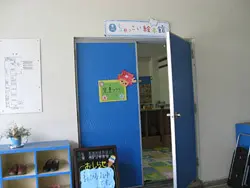



[21 August 2013, ONAGAWA, JAPAN]
 |
| © Japan Committee for UNICEF |
| Orange Houses just over one and a half years after completion, the project was initially launched to provide children with a place to play after school. Today, the functions of these Orange Houses have expanded to include various public services for local residents. On 21 August, Miyagi Association for UNICEF representative Eiko Igarashi visited the facilities and commented that, "The houses are being used so carefully that they still appear to be brand new." |
Onagawa (Miyagi) suffered a tremendous loss in the Great East Japan Earthquake, with a large portion of its population dying or missing. Onagawa was thus one area where the Japan Committee for UNICEF (JCU) focused its emergency and reconstruction assistance particularly during the first year following the disaster. Today, nearly two and a half years have passed and the facilities built through the generosity of JCU's donors continue to support the lives of local children and adults.
The little land left following the disaster was used for temporary housing, making securing places for children to safely play a common challenge across all the affected areas. This was a particularly serious challenge for Onagawa, where nearly 70 per cent of the town's buildings were washed away in the tsunami, making the need for a rapid response all the more important. For this reason, JCU provided trailer houses—which can be constructed in a very short timeframe—that could be used as a place where children could play safely after school regardless of weather conditions. The three trailer houses—dubbed "Orange Houses" because of their color—were completed by Christmas 2012 (one house was donated to Onagawa by actor Masatoshi Nakamura).
Today, nearly two years later, one of the Orange Houses has been converted into a local legal consultation center, one a child-rearing assistance center, and one a school counselor center. In this way these Orange Houses provide a diverse range of essential public services to community residents. An Onagawa Town official commented, "There is a shortage of private rooms where consultations can be held, so we are tremendously grateful for the Orange Houses."
 |
| © Japan Committee for UNICEF |
| The Chakkoi Picture Book Library at Onagawa Daini Primary School was created two years ago as part of the UNICEF Children's Mini Library project. The UNICEF blue painted on by volunteer artists and community members still shines bright to this day. Miyagi Association for UNICEF representative Eiko Igarashi commented that, "You could really tell how much they treasure the library by how well they have kept it up." A sign on the entrance reads "Nap Time". The library is also used for after-school activities. |
The UNICEF Children's Mini Library project was launched with the aim to restore smiles to the faces of children in the affected areas. Over 300,000 picture and children's books were donated from across Japan and distributed at kindergartens, preschools, primary schools and numerous Fukushima households with small children who were left unable to play outside.
Before the March 2011 disaster, Onagawa had been preparing to open a picture book library in June 2011. The tsunami, however, washed away the some 400,000 picture books that had been collected in preparation for opening. JCU responded by pulling together approximately 5,000 picture books from the UNICEF Children's Mini Library project, as well as donations from other civil society organizations and corporations.
Despite being unable to implement the initial plans to build a picture book library, JCU responded to a request from Onagawa by providing bookshelves and mats as part of its child friendly spaces assistance campaign. Artists volunteering in the planning, production and operation of the UNICEF Children's Mini Library project traveled to Onagawa to complete the Chakkoi Picture Book Library at an open space at Onagawa Daini Primary School on 10 May, two years after the disaster. In August 2013, the library reopened at the entrance of the stairwell to one of the school buildings, the strategic position enabling children to use the library even when the school is closed.
Today, the Chakkoi Picture Book Library is also used as a space for after-school activities. The picture and children's books generously donated from across Japan continue to provide a place for children to relax and learn.